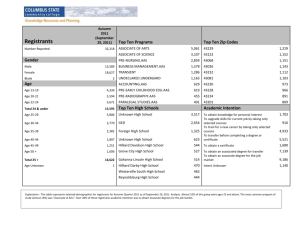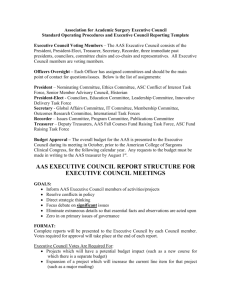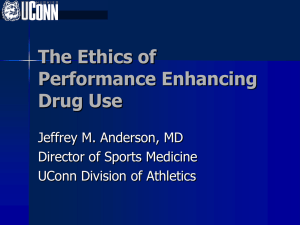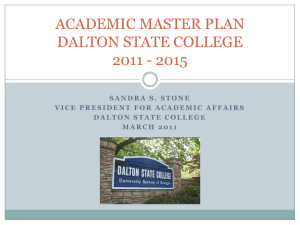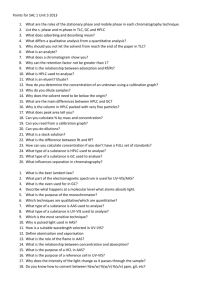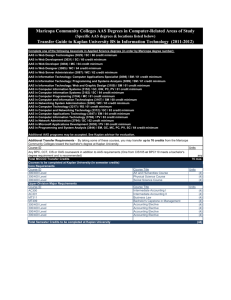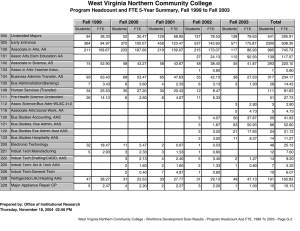Final - Utah Valley University
advertisement
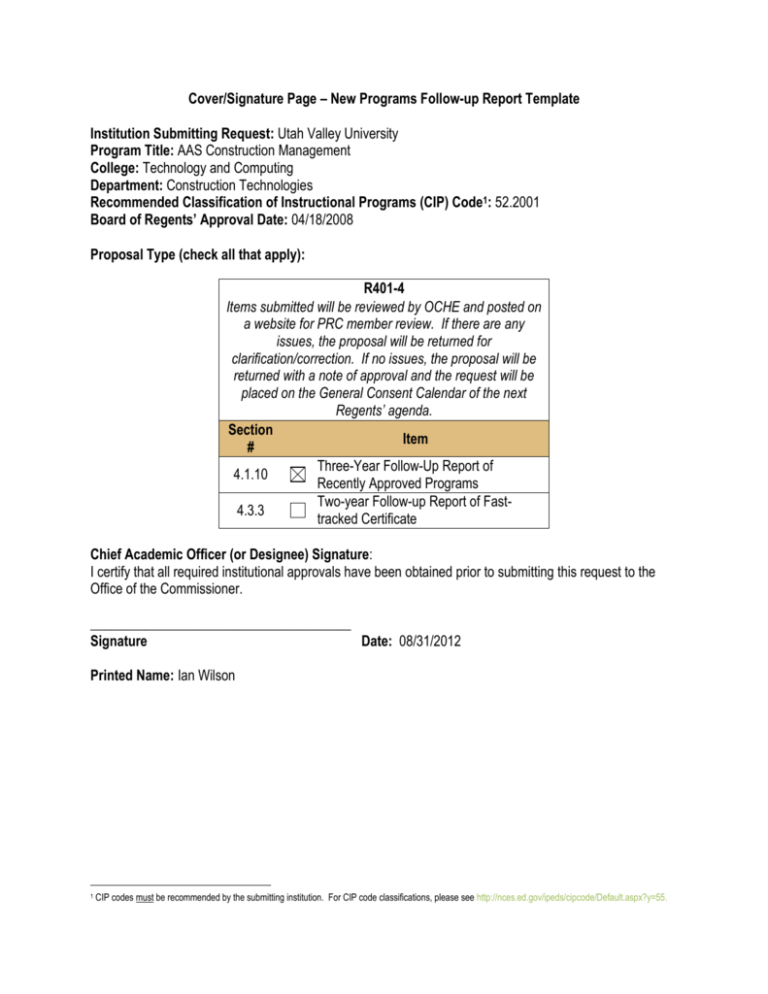
Cover/Signature Page – New Programs Follow-up Report Template Institution Submitting Request: Utah Valley University Program Title: AAS Construction Management College: Technology and Computing Department: Construction Technologies Recommended Classification of Instructional Programs (CIP) Code1: 52.2001 Board of Regents’ Approval Date: 04/18/2008 Proposal Type (check all that apply): R401-4 Items submitted will be reviewed by OCHE and posted on a website for PRC member review. If there are any issues, the proposal will be returned for clarification/correction. If no issues, the proposal will be returned with a note of approval and the request will be placed on the General Consent Calendar of the next Regents’ agenda. Section Item # Three-Year Follow-Up Report of 4.1.10 Recently Approved Programs Two-year Follow-up Report of Fast4.3.3 tracked Certificate Chief Academic Officer (or Designee) Signature: I certify that all required institutional approvals have been obtained prior to submitting this request to the Office of the Commissioner. ______________________________________ Signature Date: 08/31/2012 Printed Name: Ian Wilson 1 CIP codes must be recommended by the submitting institution. For CIP code classifications, please see http://nces.ed.gov/ipeds/cipcode/Default.aspx?y=55. Third-Year Report Utah Valley University AAS Construction Management 09/05/2012 Program Description The Associates (AAS) degree in Construction Management was approved by the Board of Regents on 04/18/2008. The program began accepting students for Fall 2008.The degree was designed to provide students a foundation in construction management that prepares them for introductory management positions in the construction industry. The program provides courses in construction science covering the heavy civil, commercial, and residential fields. Heavy civil construction elements are emphasized across the curriculum. Students learn about construction materials and green building methods through the use of readings, 3-D models, hands-on laboratory exercises, and site visits. Construction Management courses in Scheduling, Building Information Modeling (BIM), and job site management and safety are also provided. Students build a strong background in mathematics, computer technology, business, and other general education subjects. Enrollment and Revenue Data Prior to Program Implementation Departmental/Unit Enrollment and Staffing Data Total Department Student FTE 211 (Based on Fall Third Week Data) Total Department Faculty FTE 14.3 (A-1/S-11/Cost Study Definition) Student FTE per Faculty FTE 14.8 (from Faculty FTE and Student FTE above) Program Level Data Total Number of Declared Majors in X Program Total Number of X Program Graduates Departmental Revenue Total Revenue to Department $1,020,314 (Total of Funding Categories from Year 1 (08-09) Year 2 (09-10) Year 3 (10-11) Est. Actual Est. Actual Est. Actual 221 219 233 204 235 215 15.1 11.8 15.8 9.9 15.8 10.1 14.6 18.6 14.7 20.6 14.9 21.3 20 48 45 50 50 15 NA 0 NA 0 NA 2 Est. Actual Est. Actual Est. Actual $1,075,6 32 $957,75 1 $1,126,6 55 $891,84 1 $1,130,5 09 $917,58 8 R401 Budget Projection Table) Departmental Instructional Cost per Student Credit Hour (per Institutional Cost Study Definition) $6,723 X $8,261 X $7,465 X $8,226 Institutional Analysis of Program to Date The following items identify strengths and weaknesses for the Construction Management program. Strengths: 1. Industry support for hiring Construction Management graduates. A bachelor’s degree in Construction Management (or similar) is typically listed as a minimum requirement for management positions in the construction industry; however, the industry does recognize the AAS degree in Construction Management as a milestone towards the preferred bachelor’s degree. Students who have completed the AAS degree have a measurable advantage over other candidates when applying for internship positions. It shows employers that the student has focused his/her studies and completed a milestone towards a BS degree. It also indicates that the students are prepared for an internship, as the employer’s preference is to hire student interns after their junior year. 2. UVU offers many courses that students can choose as electives in related construction or business disciplines. This allows students to tailor their choices to the specific construction sector in which they are interested. 3. There are many industry experts in the surrounding area who have been willing to teach, as adjunct instructors, courses that require a high level of expertise in a very defined discipline. 4. The students in the Construction Management program have quickly engaged with industry organizations and local companies. The students, through competitions, internships, cooperative work experiences, and site visits have had opportunities to meet and work with industry professionals. Industry professionals have reciprocated with increased internship opportunities, etc. This has helped the transition from a residential carpentry program to a construction management program recognized and supported in the local area, as well as the western region. Student competition teams have placed first in 4 national competitions since the program began. 5. The majority of the Construction Management students have some level of construction experience before they come into the program. This increases their ability to understand and apply key concepts, as well as share their knowledge and experience with others in the classroom settings. Weaknesses: 1. Costs associated with competitions. The team based student competitions are very important as a capstone experience for students in the Construction Management program. As the program continues to grow, this expense also increases. While the students’ personal contribution has increased from years past, the contributions from the college and industry have not kept up with the growth of the program. In past years, the Construction Technologies 2. 3. 4. 5. department has built and sold a structure in the community each school year. Proceeds from the project helped fund student competitions and events. Recently, the college has asked the Construction Management program to emphasize heavy civil or infrastructure construction and deemphasize residential or building construction. This change in emphasis has eliminated that funding source. As such, additional funding support has been requested through the College. Until additional funding is secured, student travel and competition funds are reserved primarily for students in their junior and senior year. Students pursuing the AAS are encouraged to participate in local competitions. The Construction Management faculty is made up of one Ph.D. candidate in civil engineering, with an extensive background in heavy civil and heavy highway construction; two faculty (one Ph.D. and the other enrolled in a Ph.D. program) have, primarily, residential construction management and development experience; one faculty has completed an MBA and has a background in industrial and residential project management; and two faculty have strong applied construction experience, primarily in the residential sector. To overcome this imbalance, as new faculty are hired, an emphasis on experience in heavy civil, or preferably heavy commercial construction management will be a top priority. The need is also currently being addressed through the Planning, Budgeting, and Assessment process. As future faculty needs are being assessed, the following are important considerations: a. Heavy Civil or horizontal construction functions are utilized and taught throughout the program, but the vast majority of the students (at least 68%) are pursuing careers in vertical construction sectors. b. A survey of Construction Management students at UVU completed on 8/29/12 by the Construction Technologies department indicates that students are pursuing careers in the following construction sectors: i. 43.2% Commercial ii. 25% Residential iii. 11.4% Heavy Civil iv. 2.3% Industrial v. 18.2% Undecided c. In order to meet the desires of the program, donors, as well as the overall needs of the program and students, hiring (as needed) new faculty with a heavy commercial background could help accommodate both needs. Most of the upper division courses have extensive pre-requisites. Students must start taking pre-requisite courses such as mathematics and remedial courses early on to be prepared and/or qualified to take upper division courses. This extends the time that students are in the Construction Management program. The proposed Structured Enrollment plan should remedy this problem by requiring students to take remedial courses earlier in their program. Weak market conditions that currently plague the construction industry have discouraged and/or dissuaded some potential construction students from joining or continuing the program. Low enrollment numbers in the Construction Management AAS degree. The enrollments in the BS degree have continued a growth pattern similar to initial projections. This is in part due to the fact that students who have previous credit or associate degrees do not need, or have not chosen to pursue the AAS degree. They have chosen to focus only on the BS degree. Through counseling and faculty interaction, the department of Construction Technologies intends to help students understand the importance of completing the AAS degree as a milestone toward the pursuit of a BS degree. Encouraging students to enroll and complete the AAS in Construction Management will be a top priority for the Construction Technologies department. Although students have the BS in Construction Management as the end goal, they will complete the AAS requirements in the process. Completing the AAS degree also protects students who may need to withdraw or delay their education from returning to complete their studies, only to learn that all of their math requirements have expired and must be repeated. Employment Information Term Graduated 2008-09 2009-10 2010-11 Graduate School Employed in Field Employed Other 2 Unknown


